I made 6 gallons of liquid soap so you don’t have to.
You know about Dr. Bronner’s Liquid Castile Soap. It’s been an all-in-one, all-natural cleaning solution for generations of hippies, greenies and all manner of natural living advocates. Dr. Bronner’s is great, but it’s not the cheapest cleaner out there.
So, these were my goals: to create a cost-effective, basic liquid soap that most people could make with the gear they have around the house and commonly available oils.
I wanted a recipe that was reliable, safe and performed similarly to Dr. Bronner’s in home and body care recipes. The result should be enough finished soap to make this worth the DIY hassle, but not so much soap that it would be overwhelming to store or use in a reasonable timeframe. My goal was a total of about 1 gallon of finished liquid soap.
Two weeks and 6 batches of liquid soap later, I think I’ve gotten it down. Wanna make your own liquid castile soap? Here’s how I do it.
1. Assemble Your Stuff
Like any true soap, liquid castile soap is made through the chemical reaction of fats and a very strong alkali called lye. This reaction is called saponification; when it’s complete the fat and lye are totally transformed into a new thing we call soap.
Tools You’ll Want To Make Liquid Castile Soap
The process of making liquid soap is make a zillion times easier if you have:
- A large crock-pot (6 quarts or larger, please). If you don’t already have a crock-pot, check the thrift store first. I have an older version of this crock pot. It’s fine. I think they are all about the same, honestly.
- An immersion blender – I like the kind with a stainless blender attachment.
- A reliable digital scale that can measure both ounces and grams. I have this kitchen scale. It’s been really good.
Any time you’re working with lye, use only heavy-duty glass or stainless bowls. No aluminum, please, or you’ll find both your soap and your vessel quite destroyed.
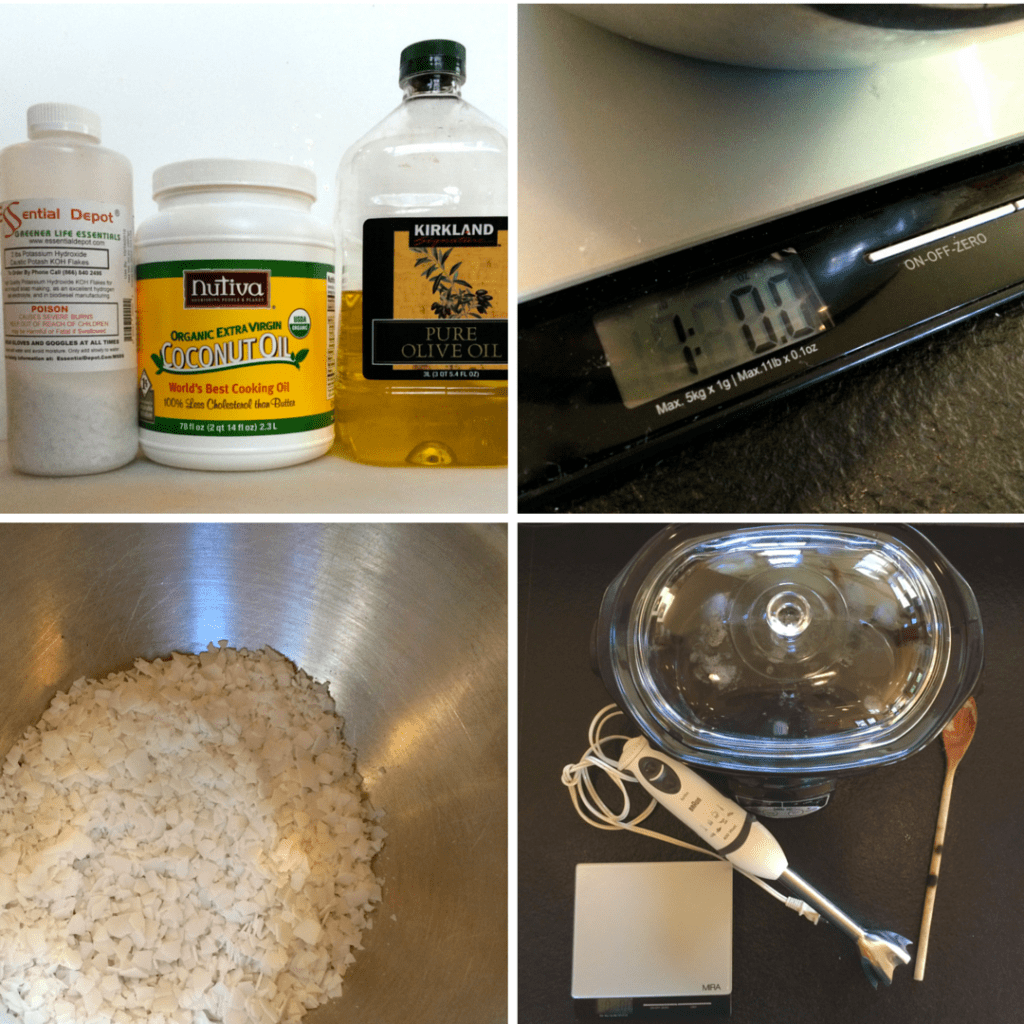
Essential tools: crock pot, immersion blender, digital scale.
Lye For Liquid Castile Soap
Liquid soap is made with a type of lye called potassium hydroxide. This is the lye you want.
Potassium hydroxide is different from sodium hydroxide, the drain cleaner lye used to make a hard bar soap.
These two lye saponify differently, are used at different rates, and result in different textured soaps. So, even though both are called lye, sodium hydroxide and potassium hydroxide are not interchangeable in soap recipes.
- Potassium hydroxide saponifies fats without forming hard, opaque crystals so the resulting soap can be diluted to a liquid consistency without getting gloopy.
- Potassium hydroxide tends to give a more bubbly lather, highly desirable in liquid soaps.
- Potassium hydroxide is only about 90% pure as compared to nearly 100% pure sodium hydroxide, and this must be accounted for when you create a liquid soap formula. (See more about this in the Lye Calculations for Liquid Soap sidebar)
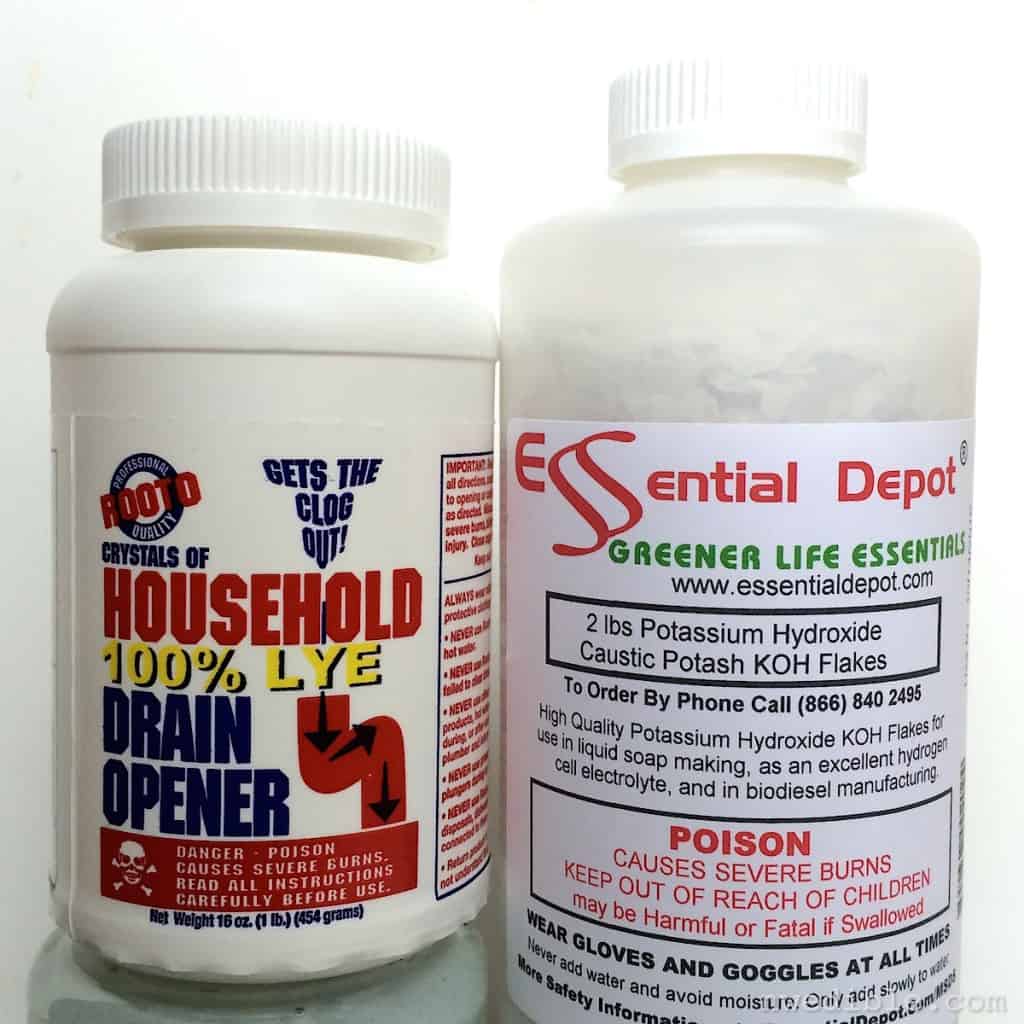
Sodium hydroxide for bar soap on left; Potassium hydroxide for liquid soap on right.
Oils For Liquid Castile Soap
Castile soap is made exclusively with vegetable oils. There will be no lard, tallow, or other animal fats in a Castile soap. Traditionally, a Castile soap was made with 100% olive oil, but modern Castile-style soaps, including Dr. Bronner’s, blend in other vegetable oils, like coconut.
For my liquid soap, I used a 60/40 blend of easy-to-find olive and coconut oil. That’s what you’ll see in this tutorial.
- Olive oil is mostly long-chain fatty acids. Olive oil soaps have a fine, moisturizing lather that’s gentle on the skin but can feel slimy on its own.
- Coconut oil is full of medium-chain fatty acids which create a soap with strong cleaning ability and big, well-structured bubbles. Coconut oil soaps can be drying because they grab and hold oil – i.e., clean – really well
Put coconut and olive oil together and you get, in my opinion, a nice, all-purpose liquid soap with good bubbles. The result is a cleanser that is strong enough to tackle greasy grime in your kitchen while still being skin-friendly.
2. Prepare The Oils and Lye Solution
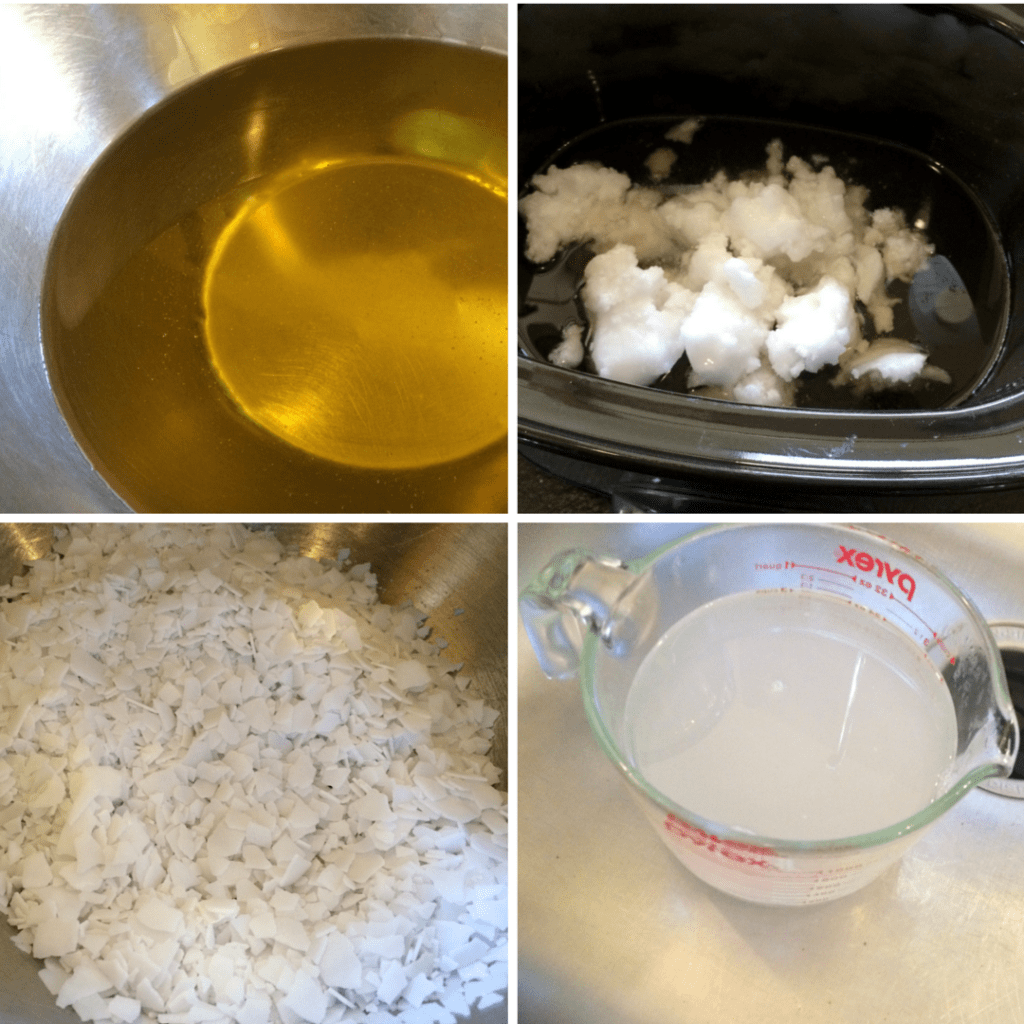
Measure all ingredients carefully. No one wants a Fight Club situation.
Carefully measure the olive oil and coconut oil into your big ol’ crock pot. Turn the heat to high to allow the coconut oil to melt.
While the oils are warming, carefully measure the water into a stainless steel bowl or pyrex pitcher. Set the container of water in your sink.
Put on your safety gear: heavy rubber gloves, goggles, etc. Measure the potassium hydroxide lye flakes into a small stainless or heavy duty glass jar. Carefully tip all the lye flakes into the water. Never add the water to the lye – always add the lye to the water.
The lye-water mixture will bubble, hiss and look generally terrifying. This is normal. Don’t stick your face over the lye mixture or breathe in the lye fumes. The lye flakes will dissolve quickly – give them a careful stir if needed to encourage this.
3. Stick Blend Your Soap To Trace
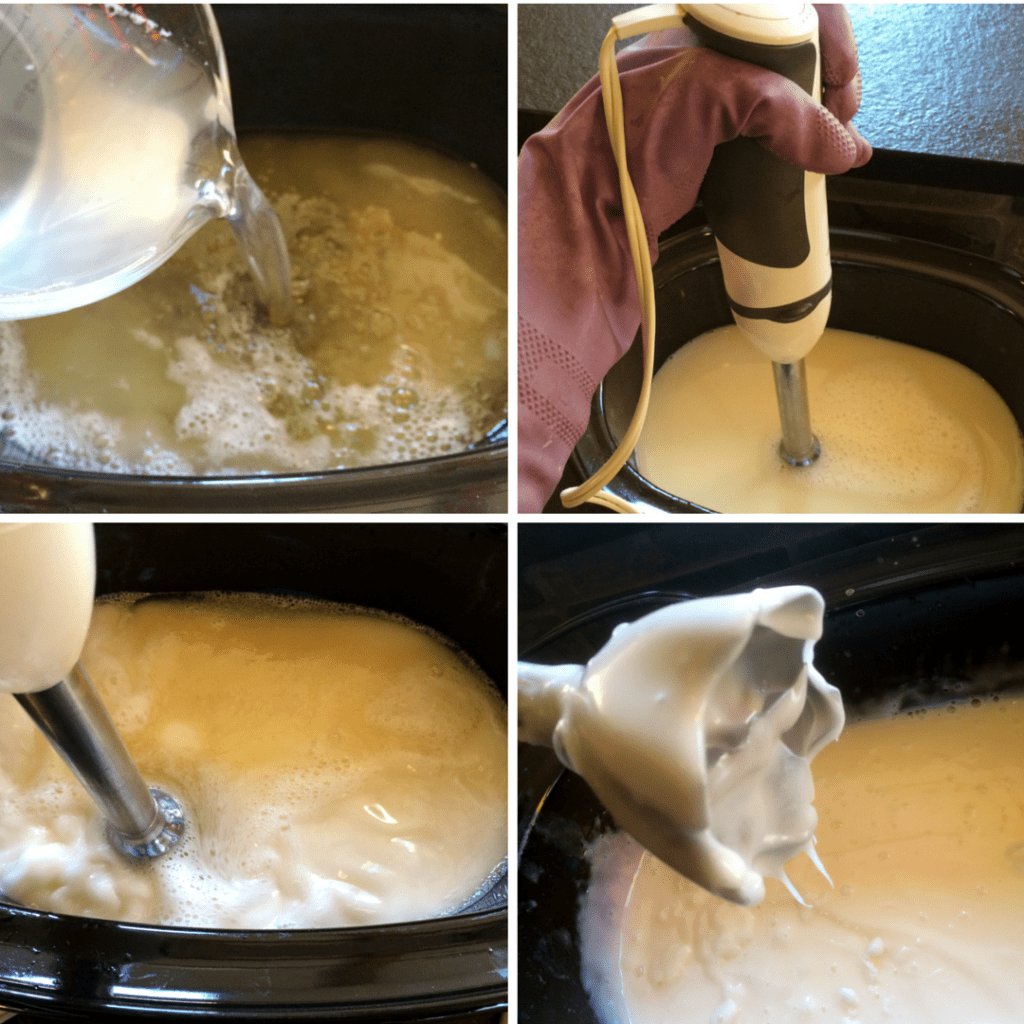
Stick blend to thick trace – look for a texture like Elmer’s glue.
You’re still wearing your gloves and stuff, right? Good – it’s time to bring the oil and alkali together to create soap, glorious soap.
When the lye is fully dissolved, carefully tip the lye-water mixture into the warm, melted oils in your crockpot.
Get out your immersion blender. Blend the soap mixture on medium until it turns uniformly creamy and begins to thicken slightly. This should take about 5 to 10 minutes.
Now, go do something else, but don’t stray too far. For the next half hour or so, come back to the crock pot every 5 minutes and give your soap a good blending with the immersion blender. Every time you show up for blending duty, you’ll notice your soap paste gets thicker, paler and more bubbly.
Keep periodically blending until your soap reaches a thick trace – you’re looking for a texture like Elmer’s glue – and it’s no longer practical to use your immersion blender in the soap.
4. Cook The Soap Paste

Give the soap paste as much time as needed to get to the fully gelled, translucent stage shown lower-right.
At this point we begin to “cook” our soap paste. With your crock pot still on high heat, adjust the timer to 3 hours and set the lid on the crock pot.
As the soap cooks, it will become increasingly translucent, moving from a runny white liquid to a puffy taffy texture to, eventually, a yellowy-clear, thick gel. This is normal. I think of these stages as:
- runny cream
- cake batter
- Elmer’s glue
- puffy white taffy
- confused semi-gelled blob thing
- translucent gel
During this cook period, we’re going to take the soap from Elmer’s glue texture to finished, translucent gel. The soap paste in the crock pot will mostly tend to itself during this time.
To keep the gel progressing evenly, periodically fold your soap paste over on itself and stir it around with a sturdy wooden spoon (very sturdy – I broke a spoon on soap batch #4) or high-heat spatula.
As the soap cooks, it will get puffy as the air bubbles trapped in the soap heat up and expand. Eventually, the paste will start to look more translucent. If your crock pot has hot spots, you may see some chunks of fully gelled soap even if the bulk of the soap paste isn’t ready.
That’s all ok.
Just aim for a good fold-over and stir about every 30 minutes or so, or more often if you can. After 3 hours, check your soap paste. When your paste is done it should look quite a bit like amber – translucent and golden.
Don’t rush getting to this stage – if your soap needs more time at the end of the 3 hours, take the time to cook the paste for longer – nothing bad will happen to the soap paste.
5. Check Clarity
Once the paste looks fully gelled and translucent throughout it is ready for the next stage.
At this point, the soap will probably be fully saponified and ready to dilute. But better safe than sorry, so before we commit to dilution, we’re going to do a clarity test.
Clarity (in combination with carefully measured lye) is a very good test of full saponification. If your soap paste makes a cloudy dilute soap, it is not done cooking. Cloudy soap* can indicate non-saponified oil (too much of this can make your soap go bad) and potentially non-saponified lye (this can cause chemical burns).
If, however, the diluted final soap is translucent enough to read through, your soap paste has finished cooking.
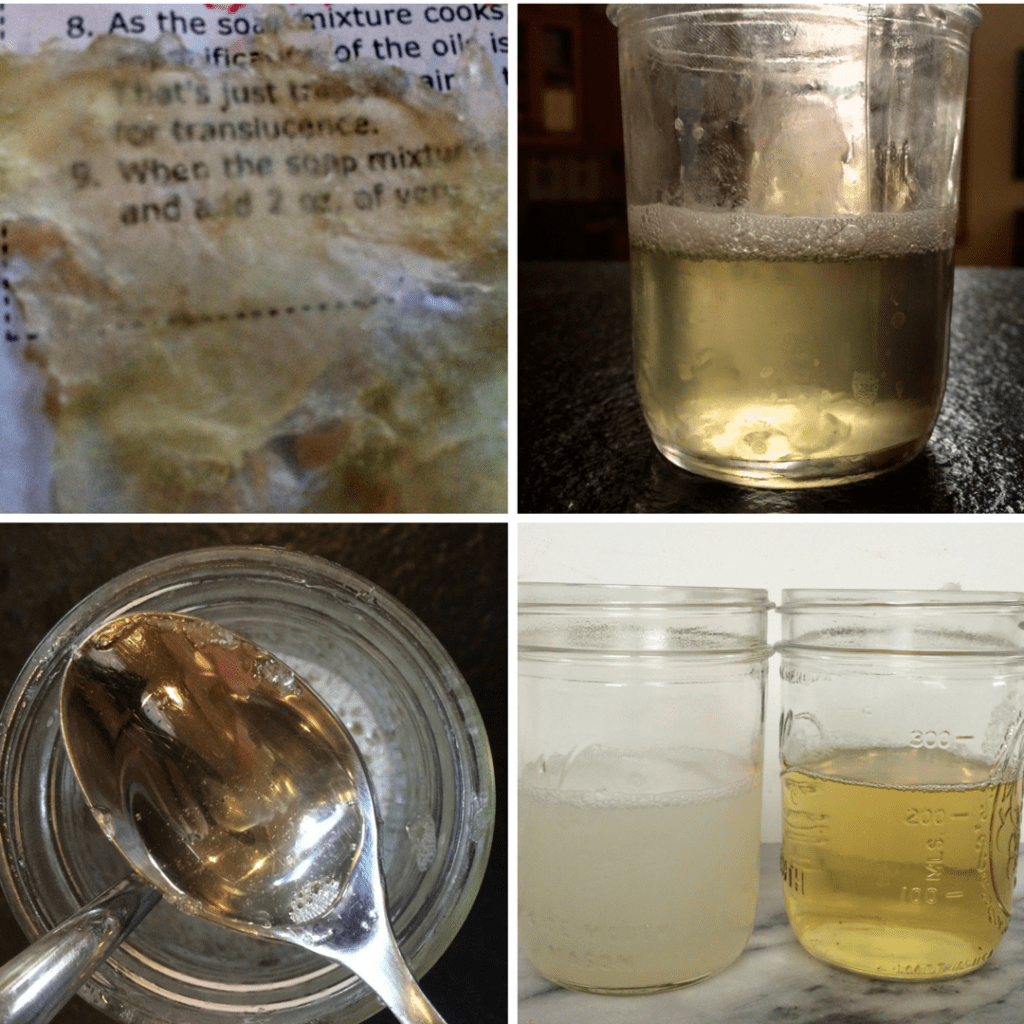
Lower-right: cloudy, unfinished soap on left; translucent, finished soap on right.
To Test Soap Clarity
- Measure out an ounce of soap paste (about a golf-ball sized blob will do it).
- Add 4 oz (1/2 cup) of boiling or very hot water to the soap paste. Stir gently until the soap paste is totally dissolved.
- Allow the dilute soap to cool.
- If the soap is opaque, or if a scum of oils floats to the surface, continue cooking your soap paste for another hour or two before re-testing.
- If the dilute soap is clear or slightly pearlescent (the soap won’t be colorless, just translucent), proceed with dilution.
*Alternate Oils and Clarity
If you change up the oils in your soap – and particularly if you use tallow, lard, palm, or other “hard” fats – you may end up with a soap that never becomes completely clear.
There’s nothing you can really do about this, as I understand it – it’s just a matter of the type of fatty acids in certain oils.
The coconut and olive oils used in the formula given here should cook out to a fully gelled soap paste in between 3 to 6 hours, depending on the temperature of your crockpot, how often you stir, etc.
6. Dilute the Soap Paste
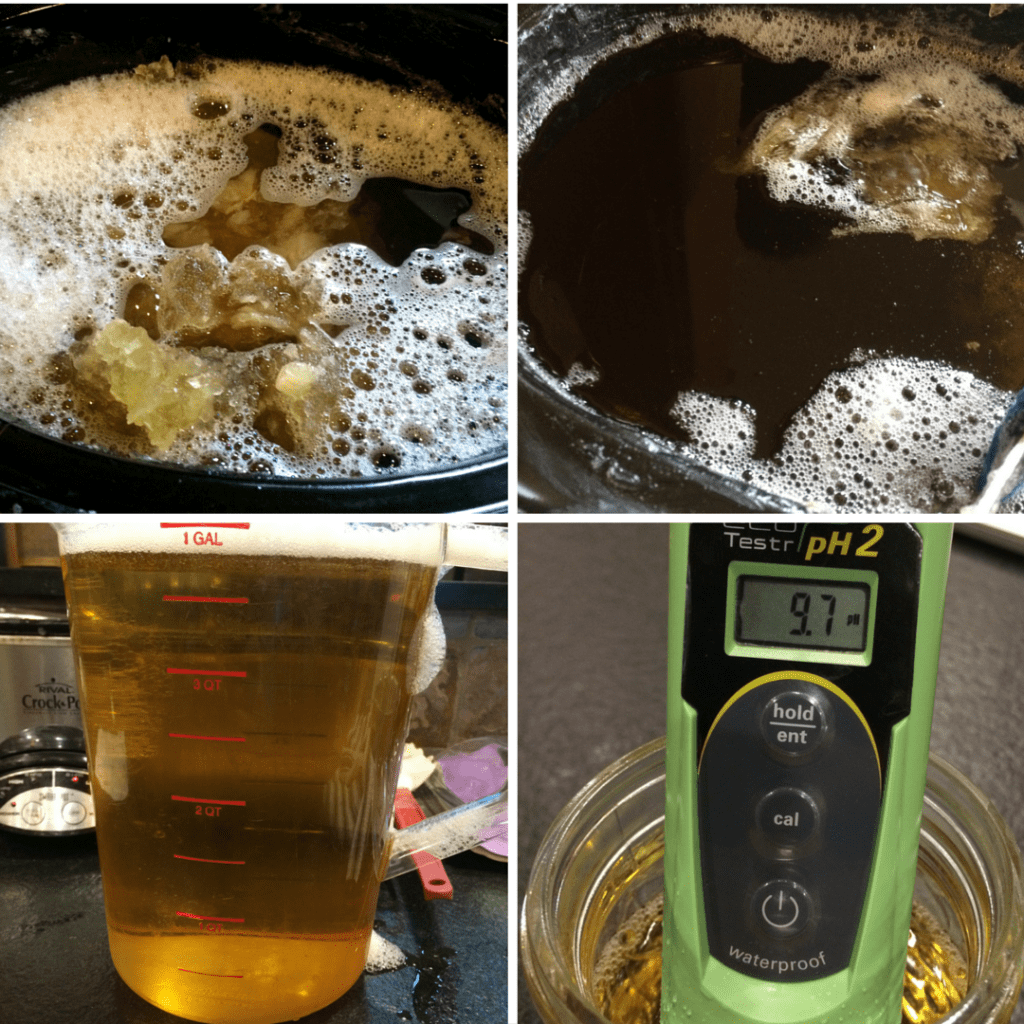
The melting process is very slow.
Once the soap paste has fully gelled, proceed with dilution. Like the cook phase, dilution of the paste is a sloooowwww process, but the soap will pretty much take care of itself.
Add 10 cups distilled* water to the soap paste in the crockpot. Break up the soap paste into the water into smaller blobs of paste as best you can but don’t worry about the paste dissolving yet.
Turn the crock pot heat to keep-warm, lid the crockpot and give the soap paste all day or overnight to dissolve. If possible, every hour, or as you happen to think of it, give the soap a stir to help it along. (If you’re sleeping during this phase, don’t worry about stirring!)
If, after 8 hours-ish, you’re still seeing a lot of chunks of soap, or you see a skin forming at the top of the soap, add in another cup of distilled water and let the soap continue to dissolve. Repeat with the final cup of distilled water if needed.
When your soap is fully dissolved with no chunks of soap paste remaining, it’s ready to bottle.
*Is Distilled Water Necessary?
I call for distilled water for three reasons.
- I have no idea what the pH and mineral content of your water is. Mine is 7.4 – pretty neutral – and soft like a baby’s butt. You might have tap water so full of minerals it’s practically gravel, with a pH of 9.5. That’s just way too much starting variation for a soap recipe that doesn’t ask for pH testing and buffering.
- Impurities in water – mostly those aforesaid minerals in hard water – can cause soap to do funny things. Clumping and particulate are possible.
- There is a miniscule possibility that contaminated tap water could introduce spoilage organisms to your soap on dilution.
The most important reason is (1) – so if you have a way to test the final pH of your soap, such as a pH meter or phenolphthalein pH testing drops, and feel confident adjusting your soap pH with a citric acid or borax buffer if necessary…well, then honestly you probably don’t need this soap tutorial at all! 🙂
I have made this recipe with my own near-neutral, soft water without issue. Hard water folks might find tap water trickier to work with from an impurity standpoint.
7. Bottle and Adjust Quantity
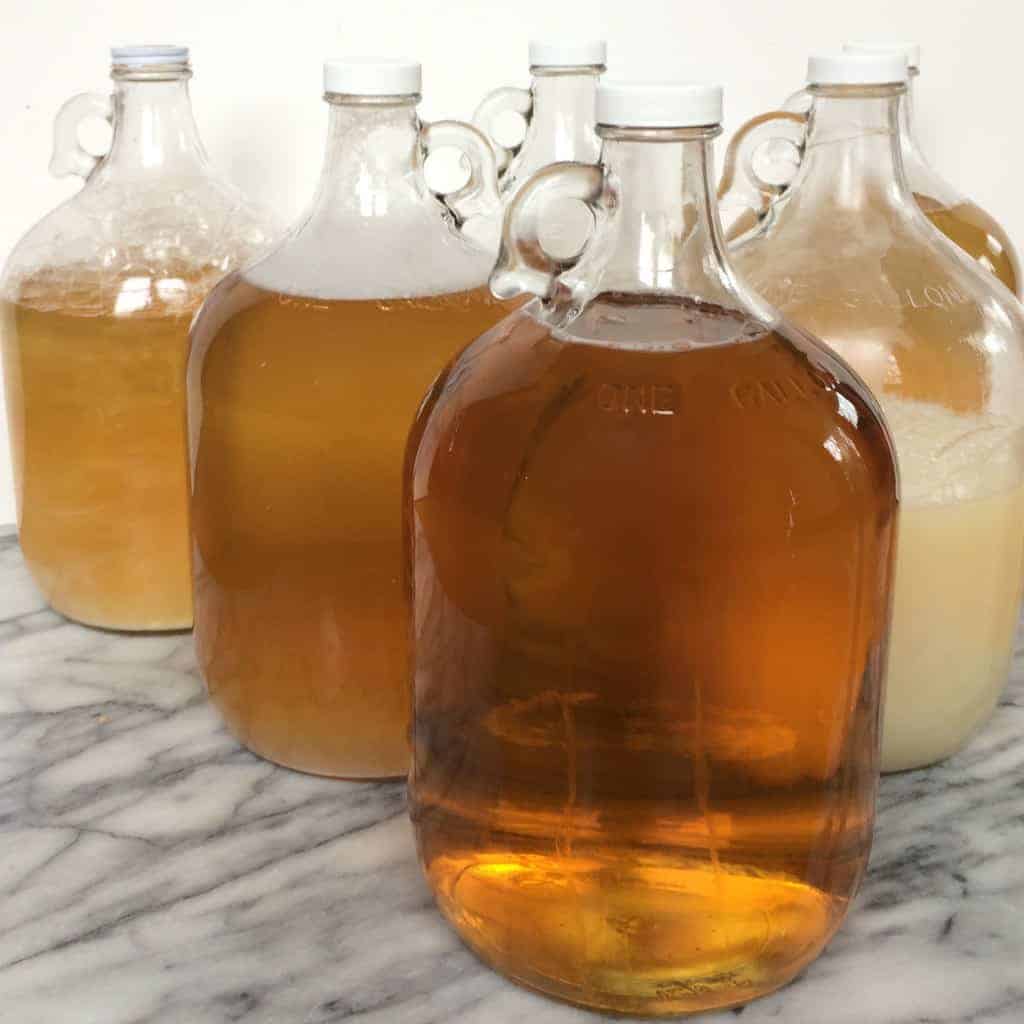
I have a lot of soap now.
Before bottling, I like to strain my soap to catch any bits of scum or soap paste that hasn’t fully dissolved. This is optional, but it doesn’t add much time.
Ladle or carefully pour your dilute soap into a perfectly clean and dry 1-gallon glass or plastic jug. Old apple juice, milk or vinegar are good for this – just ensure any reused container is thoroughly cleaned.
Your soap should be just about the right volume to fill your jug with maybe a pint or so left over for topping up soap pumps around the house.
But, because of different cook times for the soap paste, evaporation, how much water you added, etc, your soap might be a bit low. If that’s the case, just top up your soap with a bit more water until you’re at that 1-gallon mark.
Lye Calculations For Liquid Soap
You cannot simply swap one oil for another in a soap recipe.
If you prefer to change up your base oils or your base oil quantities, make sure to run your modified formula through a reliable soap making lye calculator to determine how much potassium hydroxide (often referred to by it’s chemical notation KOH) you will need to use.
Assuming you are using commonly available KOH flakes, you have to account for the fact that your lye is only 90% pure. If you have gotten your hands on some kind of industrial, super-high purity KOH you’re on your own when it comes to your lye calculations.
Good lye calculators like Soap Calc will have an option for 90% KOH. Use that formulation with a 3% superfat.
Again: you must run any variation or modification of a soap recipe (any soap recipe!) through a soap calculator to ensure safe and complete saponification. This is for your safety!
What’s The Cost?
As of the writing of this post, my cost for a batch of this soap using organic oils was as follows:
- Coconut Oil – $10.25 for 16 oz = $0.64/oz * 16oz = $10.25
- Olive Oil – $17.75 for 34 oz = $0.52/oz * 24 oz = $12.53
- Potassium Hydroxide Lye – $12.99 for 32 oz = $0.41/oz = $3.90
- Total = $26.68
Using bulk oils from Costco and the ingredient cost drops to about $18.
So, a batch of this soap should come in at about $20 – $30, depending on where you get your ingredients and if you opt for organic or otherwise more expensive base oils. That’s between one-third to one-half the cost of Dr. Bronner’s.
Printable Recipe For Liquid Castile Soap
DIY Liquid Castile Soap
Ingredients
- 24 oz weight (680 grams) olive oil
- 16 oz weight (454 grams) coconut oil
- 9.35 oz weight (265 grams) Potassium hydroxide lye flakes
- 32 oz (4 cups | 907 grams) distilled water, for lye-solution
- 10 to 12 cups distilled water, to dilute, plus extra as needed
Instructions
Make The Soap Paste
- Add the olive oil and coconut oil to a large, (6 quart minimum) crock pot. Turn the crock-pot on high.
- While the oils are warming, put on your safety gloves and goggles, and carefully measure the potassium hydroxide lye into a stainless steel or pyrex bowl.
- Measure the water into a medium stainless bowl or pyrex pitcher. Set the container with the water into your sink, then very carefully tip the lye flakes into the water. Stir to dissolve.
- When the oils in the crockpot are warm, carefully tip the lye solution into the oils. Leave the crockpot on high.
- Use an immersion blender to blend the oils and lye solution together. Immediately after adding the lye solution to the oils, blend for about 5 minutes, until the mixture looks uniformly opaque and begins to slightly thicken. For the next 30 minutes, come back and blend the soap paste about every 5 minutes. The mixture will get thicker and thicker, progressing through an icing texture to something like Elmer's glue.
Cook Soap Paste
- When the soap mixture becomes too thick to blend with an immersion blender, lid the crock pot and cook the soap mixture for 3 hours on high.
- Every 30 minutes or so, come back and fold and stir the soap paste with a heat-resistant silicone spatula or heavy wood spoon to ensure the soap paste cooks evenly.
- As the soap cooks, it will become increasingly translucent, moving from a runny white liquid to a puffy taffy texture to, eventually, a yellowy-clear, thick, translucent gel.
Test Soap Clarity
- After 3 hours, or once the paste looks fully translucent and gelled throughout, check the soap with a clarity test.
- Measure out an ounce of soap paste (about a golf-ball sized blob will do it). Add 4 oz (1/2 cup) of boiling or very hot water to the soap paste. Stir gently until the soap paste is totally dissolved.
- Allow the dilute soap to cool. If the soap is opaque, or if a scum of oils floats to the surface, continue cooking your soap paste for another hour before re-testing.
- If the dilute soap is clear (it needn't be colorless, just translucent), proceed with dilution.
Dilute the Soap Paste
- Add 10 cups water to the soap paste in the crockpot. Break up the soap paste into the water as best you can but don't worry about the paste dissolving fully.
- Lid the crock pot and turn the heat to warm for 8 hours or overnight. If you happen to walk by, give the soap a stir to help it along but don't worry if you can't.
- After 8 hours, if you notice chunks of remaining soap or thick skin of soap forming even after the chunks of soap dissolve, add another cup or two of water to further dilute the paste.
Bottle Soap
- When your soap is fully dissolved with no chunks of soap paste remaining, ladle your dilute soap into a perfectly clean and dry 1-gallon glass or plastic jug.

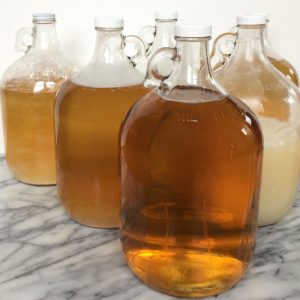
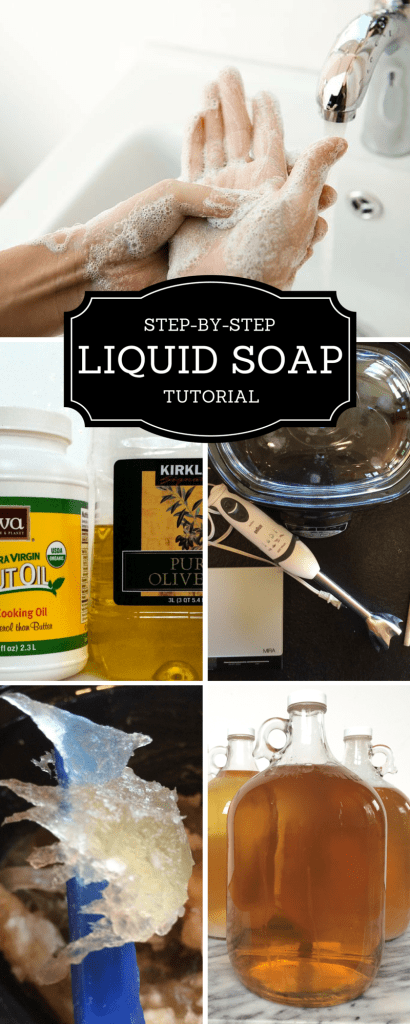
Um, Erica – I love you. This article is exactly what I’ve been needing, and it makes the process seem so approachable. I’m curious – have you had any luck adding essential oils like tea tree, citrus, lavender, etc?
I’ve made soap jelly on accident by trying to dilute/dissolve (sodium hydroxide based) hard soaps, and I’m relieved that I now understand that the cation makes all the difference!
Hi Carolyn – re Essentail Oils – yes! But what I recommend is you scent with EO’s as you use / further dilute the soap. I think I found 20 drops per pint of finished soap was about right – I will do another quick post on some options for scenting and using this soap later; but the tutorial was 3000+ words and needed to end somewhere. 😉
But yeah, totally ok to play around with scents; I’d just do it in batches, not the whole 1 gallon+ batch at a time.
I plan to use this in place of Dr. Bronner’s for a hand and body wash recipe. When you say, “further dilute the soap,” how much more dilution is necessary before I use it?
This will be my first attempt at soap making, so thanks in advance for your input.
I have been making liquid sop now and used Failors book as a guide. I use the various calcs such as soaqpcaqlc MMC and Summerbee and always go with the most conservative lye weight
But one thing I Cant get right is DILUTION. Some recipes range from 40 – 90% water on initial cook and then how much water do you add ? Considering it is impossible to really tell how much water is left unless you weigh your cooked paste.. this part baffles me.
I have learned a few things too. Perfect LS is crystal clear but tinted with the oil colors. If you Citric acid down to far.. it starts to go cloudy. But mix it with some non citric soap, and it corrects again. I actually got my PH down to 7 according to my PH litmus paper. My PH meters are notoriously unreliable and I do not know where to buy good one. There is a chemical soapers use that turns pink if there is any remaining lye… I will get that next time but from what I see.. if you make LS, you can aim for about 98 – 99% giving a 3% or so Super fat.. and if there is any excess fat in there – it will either not matter if you used caster oil (which you should for lather etc), or with a bit of glycerine. You can also use Borax in soap. There is lot of controversy over this as it may cause skin irritation but boron is a natural element many of us are lacking and you can actually eat borax aka boric acid as it has the same LD50 as table salt.
I also no longer throw away batches that look like they failed. If the chemistry is sound, I put the log in a jar with some water, and leave it. This is a jar with a tap on the bottom. My last failed batch settled out and a scum of fat and rubbish that was not soap all settled to the top, but 3/4 of the jar was lovely liquid soap. I tapped it off and saved most of the cook. So a bit of patience and faith in chemistry. Other lessons I learned is not to Superfat too much or it wont turn to soap. And do not try using borax or citric in hard soap ie NaOH…. it never works out. Also do not superfat hard soap more than 4-5% but you can hot process hard soap and add 2% oil AFTER the cook but it makes a softer bar. Soap is a wonderful thing to play with and if you have chemical sensitivities like me, it is critical. I would say one thing… I only use organic NON chemical extracted oils. Too many soapers use cheap nasty oils which to me – defeats the entire idea of making your own soap.
Wow, awesome tutorial! I have yet to overcome my fear of lye….Fight Club anyone?….but I’ll eventually get over it and add soap-making to my repertoire. 🙂
Way less intimidating than you’d think once you’ve done it a few times. 🙂
Do my tools (crock-pot, blender, etc) need to be exclusively used for soap now ? Or can I still use them for food ?
By the time you’re done with this, the only thing left in your crockpot will be soap – luckily it rinses out pretty well. 😉
I use the same tools I cook with without issue. That said, my immersion blender is stainless. I’d be less confident re-using a plastic immersion blender.
This is terrific! Have you experimented with adding essential oils for fragrance?
Yes, with good result. I recommend scenting a cup or two at a time rather than the entirety of the soap at once. As I recall, about 20 drops EO per pint seemed about right in my tests.
Argh! It won’t Pin! What am I doing wrong?!
Better now?
Yes! Thanks!
Wow. This is an absolutely awesome post. I’m inspired now to get over the fear of chemical reactions issues I have and give this a whirl. Thanks Erika, you rock 🙂
Thanks Kate – you can do it!
I usually get the “Baby Mild” variety of Dr. B’s… would you recommend just diluting it further to make the homemade version more mild? (That being said, I end up using maybe 25-30% soap on my kids of even the “mild” stuff.)
Yes, or even more. This is definitely a concentrate. My understanding is the main difference with the baby soap is that it doesn’t have essential oil fragrance – based on the ingredients I would expect the mild Dr. Bronner’s to be essentially identical to the other “scents” in pH, etc.
(I would love to hear from anyone who might know more about this!)
Ok, did some more digging. The “Baby Mild” is actually a little different from the other scents. My mistake, sorry about that.
“Dr. Bronner’s Unscented Baby-Mild Castile Liquid Soap contains no fragrance and replaces it with double the olive oil, so it is great for people with allergies or sensitive skin. Of course, it is great for babies as well!”
So really what they are saying is the ratio of oils is weighted in the baby version to be more olive oil heavy – olive oil makes a bit more gentle, skin friendly soap. What’s interesting to me is that all Dr. Bronners soaps list Coconut oil as the first ingredient, indicating that coconut oil is the primary ingredient by weight. Which suggests to me that even the baby Dr. Bronners is still not predominantly olive oil based, like the version of liquid soap I have developed here.
So I guess what I’m saying is, this version might be actually more gentle in some ways than Dr. Bronner’s. But do keep in mind, no natural soap can be made “tear free” in the same way detergents cleaners can be.
Ingredient list of baby mild: Water, Organic Coconut Oil*, Potassium Hydroxide**, Organic Palm Kernel Oil*, Organic Olive Oil*, Organic Hemp Oil, Organic Jojoba Oil, Citric Acid, Tocopherol
Compare to Tea Tree Scented, for example: Water, Organic Coconut Oil*, Potassium Hydroxide**, Organic Palm Kernel Oil*, Organic Olive Oil*, Tea Tree Extract, Organic Hemp Oil, Organic Jojoba Oil, Citric Acid, Tocopherol
Good to know! I default to the Baby Mild on everything, just in case it’s used on my kids (the husband doesn’t separate anything, he would use his soap on the kids if I let him bathe them!) and anything more mild is great in my opinion! Can’t wait to make up a big batch of this! Thank you, Erica!
This is exactly what I needed to know, too–thank you! I use Dr. Bronner’s because other soaps shred my hands to sandpaper. If your recipe is as gentle or more so, I can’t wait to try it.
Exceedingly excellent post! Soap making is one more skill I would like to add to my repertoire.
I think it is very wise to take a proactive approach to learning money saving skills that also promote connectivity (to our homes, environment, family etc).
So often people rely on learning all of these skills only when their backs are against the wall. I’m speaking from a place of experience here, not judgment. At one point my partner and I had massive debt, an expensive rental, and went out to eat all the time. You blog, Mr. Money Mustache, and a general ‘we are unhappy and will be screwed if we continue this way’ lead us to start changing out lives. I thought I could learn all the skills needed for us to accomplish a 180 degree turn in a few months…. I was so very, very, incredibly, embarrassingly wrong.
Slowly though… we learned and made plenty of mistakes, that sometimes cost more than what we would have ‘saved’. Surprisingly even though we put in 90% more effort in the cooking, preserving, gardening, and money saving than we used to we are happier than ever and have more energy.
This rant is all to say, if you are thinking of moving down this path, give yourself time and permission to make lots of mistakes but start small and start now. It will all be worth it!
This is seriously one of the greatest things ever. I am so happy and humbled to have been able to help a little bit as you opted to move in this direction!
😀 You truly have helped an enormous amount!
A million thank-you’s!
Although I’d love to imagine what a golf ball sized blog would look like, I think you meant to say golf ball sized blob.
Similarly, I think the plan was to say that clarity is just a factor of the types of fatty acids, not a fatty of the types of fatty acids.
(Your friendly neighborhood copy editor.)
Fixed, thanks.
Not going to do it. However…..I have a market buddy who is a master soap maker, and if she makes it, I will buy it, so I will pass this on!
Master Soap Maker sounds intimidating. I hope she gives my recipe the thumbs up. 🙂
Actually she is a relative newbie without official qualifications, but she took to it like a duck to water. Her soaps are little works of art and they look so edible. They smell delicious, and on top of that I get the satisfaction of supporting one young family that really wants to live in this beautiful but depressed town.
Thank you so much for this post! I have been making my own bar soap (with lye, oil, etc.) for a couple of years now, and I, too, have been trying to develop a liquid version of it, to be similar to Dr. Bronners. The way I’ve done it is quite different from your approach in that I start with a finished bar of my soap, grate it, and then dissolve it in hot water. And while the results have been passable, they have not been great in that the resulting soap has been either too thin and liquidy, or inconsistently viscous and clumpy. I have never tried a recipe like yours that starts from scratch with the intent of being a liquid soap rather than a bar soap, and cooks the soap after reaching trace, so I am excited to try it. One question I have…..have you ever tried an approach similar to the approach I’ve used (ie grating bar soap and dissolving it in hot water)? And, if so, are the results you achieve with your method significantly better? Thanks so much!
Yes, this method is definitely better for liquid soap. I tried the “melt the bar” method and reported on it here: Soap Jelly. You’ll recognize a lot of the “technical” info in this post as coming from that one.
If you already made cold process bar soap, you will be fine with this – all the “scary” parts with lye, etc. are exactly the same. Just be prepared for it to take 2 days, all told.
Thanks so much! Looking forward to trying it!
Erica thanks for the clear, easy to follow tutorial. I love your stuff. Really appreciate the work that went into this 🙂 Looking forward to making my own soap. Dr Bonner’s is hard to get hold of here in Oz (Australia).
Thanks Mara!
How many oz/grams of the paste do you end up with?
Right around 60 oz. if I remember correctly. I’ll see if I can find the recipe with all my scribbles all over it. My initial dilution was 8 cups and that was almost 1:1.
As I read this, I kept hearing Matt Damon say, “…I’m left with only one option, I’m gonna have to science the sh#t out of this.” http://m.imdb.com/title/tt3659388/quotes
6 back-to-back batches is about 3 batches more patience/confidence than I have. Your perseverance means I’m more likely to give this a try, so thank you.
I went and saw that movie in the theater for that quote! 😀
Hi Erica,
Soap making sounds fun, but I’m not convinced it’s cost effective. Once you consider a $5-10 bottle of essential oil, electricity, water for cleaning, and your time, it’s hard to argue that this soap costs just $20. There are other brands of liquid organic soaps for $50-55. To me, the risk of chemical burns and toxic fumes inhalation is worth the extra $15 or so every few months. Rather than buying packaged ingredients from Costco, buying soap from an independent small business and having my day free to save or make money in other ways would be my choice.
Totally fair and reasonable cost-benefit assessment!
I’m curious…in any of your six batches did you test avocado oil? I know that many bloggers recommend it for culinary uses instead of olive for health and cost reasons. But from all the science of your recipe I would never presume to try it without getting advice from someone who makes soap. I’m definitely thinking this would be a really fun recipe to try when the days warm up a bit more and I can either do the cooking outside or have all the windows open. Thank you so much for going to all the trouble of working out this recipe and sharing it!
No and I wouldn’t recommend it here until you’re firmly in the “just playing around with mah soap” level of comfort with the process. Avocado oil has a high quantity of what are called unsaponifiables – stuff the lye isn’t going to react to. It’s a great oil in bar soap added in as a minor fat, where that extra leftover creaminess is desireable, but I wouldn’t use it for liquid soap. It’s great just plain as a skin care oil, though, for moisturizing, scrubs and oil cleaning.
For cost savings, I would probably use Canola in place of….eh…I’m gonna say easily half the olive oil and possibly more. But do re-run the lye calculations if you change up the oils. It won’t change much, but double check.
I’m definitely not in that category! Thank you for the info on that oil. But I will stick with the recipe just as you’ve written it.
Would a 5.5quart slow cooker work? i don’t really wanna buy an extra slow cooker! 😉
Thanks!
That would be really tight. You could do just the cooking of the paste in the crockpot, then dissolve the soap and dilute in a big bowl or stainless pot. That would work fine.
I did it this past weekend. It was tight, and I had to add the water in two batches and finally topped it off a bit when I poured it into the jug. It can be done!
This is great! Have you ever tried using an herbal infusion in place of plain water?
I have not. My instinct is that any delicate herbal notes would pretty much cook out during the paste process. But, I don’t know that for sure. If you try it, please let us know how it goes.
You mentioned in a comment/reply about baby mild bronner’s that yours “is definitely a concentrate”. How do you dispense it for daily use (standard liquid soap dispenser I’m guessing)? Do you dilute it any further or is it totally done and ready for use at this point? Or do you just use a bit less per task than store bought liquid soaps?
This is fabulous, Erica. I can see myself making this during the dark, dank winter months. Today I spent seven hours in the garden and that will continue to occupy my agenda for the next eight-nine months …
It was great meeting you yesterday! I really enjoyed our chat and look forward to more experience sharing in the future!
Wow! This is one of the most (if not THE MOST) complete tutorial I’ve ever seen online. I think you answered every question! I’ll have to check out the rest of your site. Thank you!!!
What are your thoughts on using a preservative in your liquid castile soap recipe?
(By the way I just wanted to say that I’ve made my own liquid castile soap with a different recipe for a few years now. I just made yours this weekend and I have to say it by far better than my old recipe
! I just had a question about preservatives for liquid castile soaps b/c I would like to give some of this soap as a gift (it is THAT good!) and wanted to be 100% sure it was safe etc. I’ve read conflicting theories on using preservatives for liquid castile soap.)
I have a batch going right now! It’s not proceeding quite as you describe but i’m hoping it will still be “good”. Our soap never got past the confused blob stage. I’m wondering if it’s possible to stir too much? Did it get too fluffy with air? There is the possibility of course, that my measurements were not precise.
Anyway, I ran out of time and left it on warm overnight to continue cooking in the a.m. It looked great! Still very soft but translucent. I did a clarity test and it seemed fine. The remainder is diluting right now. Then I checked our test soap and it is indeed a touch cloudy. So my question is – is it still “good”? Will it clean properly and just be cloudy or is there a chemical stage that wasn’t reached? How did your “failed” test batches turn out and were they usable?
Hi!! I am cuarrently trying the recipe.
I have the exact same question!! “Is it possible I stirred it too much?”
It is gelled though not as solid as described and definetly not translucid. It hast been 5 hours so far.
Should I keep it longer? Or is it as good as it’s going to get?
Can I use whatever the result I am left with???
Cheers 🙂
Keep cooking. It’s possible that in stirring more frequently, the average temperature of the crock pot came down (you lose heat when you take the lid off) – in which case, it just needs more time.
Thank you so much for this, I’m trying to add shampoo to my list of products but every time I look up recipes they call for melt and pour soap or liquid soap or they don’t give the measurements out I want to make shampoo homemade from the very beginning and you are the only one who broke it all down for me including the superfats, others just told me to use the lye calculator but it’s confusing when you don’t know what the % of superfat should be so thank you again.
Hi Erica,
I’m so excited to try out this recipe. I’ve been looking for a liquid soap recipe similar to a Dr. Bronners for a long time with no luck.
I had a quick question about substituting the liquids in the lye solution. This will be my first time making a liquid soap although I have a lot of experience with cold process hard soaps (we own a goat farm and have been making/using goat milk soaps for many years). I was wondering if you had ever swapped out the liquid in this recipe (with a goat milk, aloe juice, etc) and if so what were the results.
I wanted to experiment with using a milk although I know there is a good chance that the cooking process would destroy many of the vitamins and good skin benefits of the milk the same way that a hot process soap might. My biggest concern, however, would be that it would cloud the gel and I would be unable to check for clarity.
Thoughts? Thanks again for such a lovely tutorial!
I really want to try this but I’m having troubles finding Potassium Hydroxide other than online (and then shipping costs more than triple). What kind of store would sell it or what other purposes might people use it for?
Thank you so much for such Valuable information. However, I do have one question regarding the quantity of the soup you end up with. Would it possible just to do half of your recipe without going through the calculation chart you mentioned? Thank you so much 🙂
Thanks for your simple and clear instructions, they’ve given me the courage to finally give this a go. I just have one question, can I cook this on the stove in a stainless steel pot rather than a crock pot – as I don’t own one?
Yes, in theory, but I don’t know how long it will take, and I don’t know what the risk of scorching on the bottom might be. If you do this in a pot, please report back and let us know how it goes!
I just did a batch in an enamel pot (my stainless steel ones are too precious to me!) and it worked great. It was about 1.5 hours faster than your estimated times in the tutorial, though. So be prepared for the sped up time line. I started out on low (2/10). And when the crock pot would’ve been moved to high, I put my burner on low/medium (4/10). It is currently being diluted on the lowest setting (1/10).
Thanks so much for the tutorial and recipe! I can’t wait to start using it!
For homemade laundry detergent, does it matter whether castile soap contains Potassium Hydroxide ((KOH)) – for liquid soap or Sodium Hydroxide (Lye) NaOH for bar soap?
You can make laundry soap with either finished bar or liquid soap (I use bar soap), but you cannot substitute NaOH for KOH in this recipe.
I was super excited to try this recipe and after two tries both turned out the same. I got to trace perfectly as expected but as the soap “cooked” the upper 3/4 became whitish and crumbly. The underneath appeared to be separated oils.
Any one else seen this? I’ve tried to Google for why but haven’t had much luck in finding the cause.
Yes, I sorta had this. Top was white, puffy and crumbly but the bottom was sort of gel-like. But that was hours ago, now it’s more like a giant gross taffy. No solutions (yet.)
Keep me posted. I ended up discarding both batches and re-do my Lye calculations and give another try later this week.
I will if you will! Threw my batch out just now. It was burnt I cooked it so long 🙁
Ok, was successful this past weekend. Did not go as described, however. Changes I made: used another crockpot. The first pot is an unusual one in that’s meant to brown meat in, so the pot part is different than other crockpots, less like a smooth, glassy finish and more like a porous terracotta. Could a chemical reaction have caused my failure? Another thing I changed is I didn’t stir so much as flip the blob over in the pot. I don’t know if agitating it too much effected it. This batch actually progressed to the gel stage but again took much longer than described. From start to finish it took 2.5 days and I’m not 100% sure I should have stopped them but I was pretty sick of it so I did. It looks ok, translucent and homogenized. I hope you can get it to work as well.
Made a big bobo, used sodium hydroxide by mistake.
Do not watch tv, talk on the phone and do soap at the same time, even if you done soap before. The shame!
Now the water has separated from mixture, any ideas what to do now? Throw it away?
Or, can it be by any miracle a fairy come over use her wand and make something else with it?
Please help!
I’m sorry – there’s so many unknowns I can’t say – in that situation I would run the recipe including the Sodium Hydroxide lye through a soap calculator to see how safe the product I’d just made was. It might be possible to pour off the excess water and make bar soap with it – but the big question mark is saponification. If the recipe as you made it would leave a lye excess I’d be very, very concerned about using it, personally.
This is an excellent tutorial. Can we use this product as a dog shampoo.
I don’t know – I’m not a dog owner, but it’s gentle enough that I use it on me and my kids. So as long as there isn’t something about dog skin or hair that’s different, I assume it’d be fine. Check with a vet or similar animal expert if you aren’t sure. I’d skip adding any essential oils however – some can irritate animals.
What a great article! Is the soap ready to use immediatly after or do we have to wait a couple of days? Thank you very much!
It’s ready to use immediately from a safety standpoint.
Hi. I’m having another question….can we do that kind of liquid soap with any kind of oils? I actually make my soap bars with different oils and to make liquid with them, I have to rape them, so I was wondering if it could be an alternative to diffrent kind of soaps?
If you change the oils, you must reformulate the lye quantity and run your new recipe through a soap calculator. I can’t predict how your modified recipe will turn out. With liquid soap you want to avoid oils with high levels of unsaponifiable fats.
My girlfriend and I made this today and it turned out great. Thanks for the excellent instructions. Is the soap supposed to be thin because I only used the 10 cups to dilute? Since we made two batches, I think I’m going to try 8 cups of water to dilute instead and see if we get a thicker consistency.
It is a thin soap, that’s very normal, like Dr. Bronner’s. But it’s concentrated – so don’t let the texture fool ya. 😉 You won’t need a ton for cleaning.
Could I use this recipe to add to a vinegar solution to create a disinfectant cleaner? I’ve read that a vinegar cancels out soap, but I’m not believing this would be the case with, say, standard washing up liquid. Thanks in advance. Great recipe btw. I’m dying to make it and feel all Breaking Bad. Xx
Got my ingredients and ready to go on my first delve into soap making! Just one question. What do I do with the soap used in the clarity test? If the batch is not yet ready must this be discarded or can I add it back in and keep cooking? And if has reached clarity, can I simply use this already diluted soap or add it back in to dilute with the rest?….oh dear…I see three question marks…and I’m about to add another!! I’ve read on another site that the gel can be stored and diluted as required….so…could I, would I, should I? Thanks ?
1. What temperature does the crock pot have to stay at while cooking the soap paste? I wonder if it was not the right temp because (see question 2)
2. what do I do if I have been cooking the thick soap paste for 6 hours and it still doesn’t pass the clarity test? It looks translucent in the crock pot, but not when I test it. I followed your directions to a “T.”
There are variations in crock pot temperature, and depending on these variations, how often you take the lid off to stir, etc., it might just take longer. Within reason and crock-pot type temperatures, you can’t really overcook the soap gel. If unsure, err on the side of additional time.
Please, please answer our questions!! I was feeling triumphant that my soap gelled and passed the clarity test, but…yes I’m one of those annoying people that changed your perfected method…I divided the gelled mixture into three and started to dilute one third with 3.3cups of water. Well, 24 hours later, seeking advice from all over the Internet, after loosing count of how many more .3 of a cup of water I have added and resorting to stick blending, I have a creamy, thick mixture, not the liquid gold I was praying for ( oh yes, a lot of that too!?!) please, please help me! I am in need of you great soap making wisdom.
You probably whipped quite a bit of air in when you stick blended. Basically, you “emulsified” your soap. Honestly, I can’t say what will happen to it now – it might clear up a bit as the air bubbles work out, but I’d guess it will stay more creamy looking. This isn’t necessarily a bad thing since you know the soap fully saponified. It should still work as soap. But next time I’d skip the stick blending if you want a translucent soap.
16 hours and counting…soap still not a clear gel. Do I still keep cooking? I measured everything out, followed the directions exactly. It started out perfectly like the recipe then…now it’s stuck on gross puffy taffy mode T_T
Welp, I guess the answer is throw it out because I kept cooking and stirring and finally it congealed into a puffy burnt mass lol! Still don’t understand what I did wrong though, any insight would be greatly appreciated!
Same thing happen to me, but I manage to bring it into the gel stage as much as possible after a over 20+ hours cooking. I dissolved in water, the soap has a good aperence BUT, stinks. Even after adding a lot of essential oil.
Did follow the recipe very closely, since made a mistake off using lye for CP on the first batch.
Oh I’m glad you were able to make it work! Mine was definitely burnt! I even turned it to low. Clarity test a failure. Back to the drawing board I guess! I only wish I knew what I did wrong so I could avoid repeating it.
Hi. I made the receipe yesterday. My soap is becoming white as it cooling on the counter…is it suppose to become that way? The ph is very high too…14….Will it be lower with the time? You say on the article that you diluate the soap…what is the percentage of water should we add? And can we use it immediatly? Thank you!
Me again! I think that I spoiled the complete batch! I can’t have a PH under 14 and all the soap turns to a creamy white! So I decided to put it back in the crockpot and let it warm another couple of hours! Maybe the ph Will be lower….so disappointed!
Thanks for this great recipe and article. I can’t wait to buy my crockpot and ingredients to make my castille soap. I am considering adding essential oils, but not sure yet. I cannot afford Dr. Bronners so this offers a great and cost friendly alternative.
Thanks for your simple and clear instructions. Well i wont to make hair shampoo from these paste, how can i make it
Thanks alot
Is the soap ready to use or does it need to cure??
In the recruitment and work market, there are a number of experts who have specialized in recruiting executives. This entails hauling out recruitment for various positions from the middle to the upper administration dockets. The executive recruitment agencies have skills in Supplying both the privat
Thank you so much! It’s great.
How long will this last? Expires?
Would you please tell me how many tea spoons are for 265 grams of potassium hydroxide?
Thanks,
I don’t have a scale, and I don’t want to buy one.
Hi May!
If you’re going to make soap, a scale is a must! Everything must be measured accurately in order for the saponificafion to complete correctly. A fraction off on measurement of the oils or the lye… and your soap could either be too harsh (damaging to the skin) OR it might be too oily which could result in your soap being bad. You can find inexpensive scales on Amazon or at Walmart. Good luck with soaping!!!
I have a question. I have read Failor, and every blog and video I can find. Today I made a 100 percent oilive oil. I neutralized with Citric which was going ok until the second time I used citric acid. The paste looks like vasoline BUT when I try to dilute it, it turns into milk with blobs of fat. It totally falls apart. Have you experienced this ? This is the fist time I made a 100 percent olive oil.
nail art easy design design in nail art
The particular ATX tend to be more well-liked these days and
thus are like the business regular. Conserve several hundred
bucks and purchase a processor that’s been regarding the market with regards to a
few months possibly even. 600 dollar gaming laptop However, the AMD processors are cheaper,
and CPU power doesn’t usually limit gaming performance.
The cost for just a gaming laptop tends to get enormous, even in case you pick out gaming ready options
with your own. Interrupt battery recharge from step . 4 above after about 1 hour.